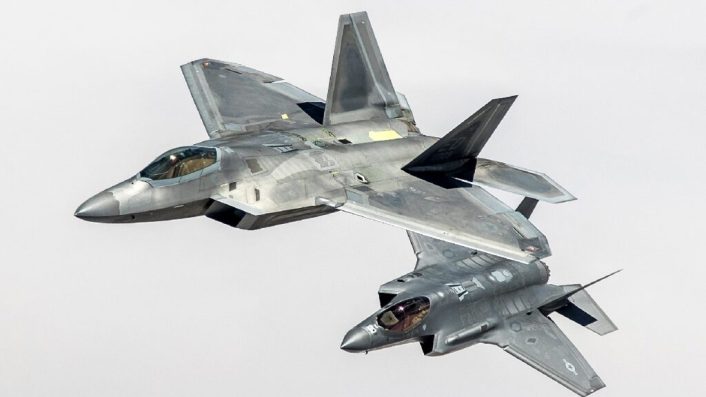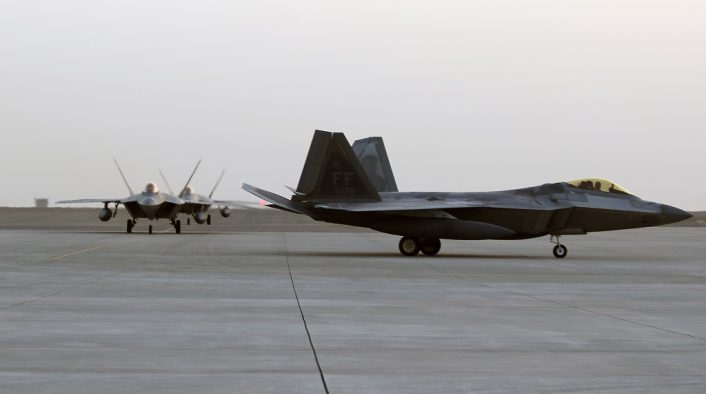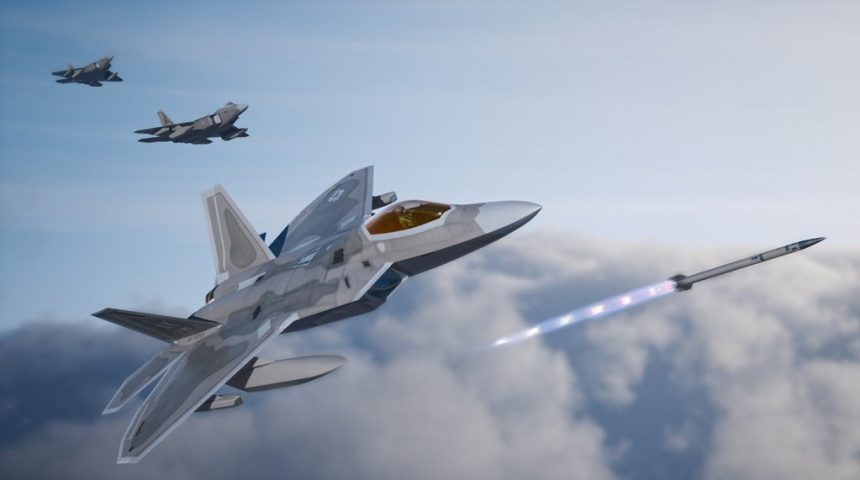The new upgrades for the F-22 have been teased both in official Air Force artworks and FY23 budget.
25 years after it entered service in the U.S. Air Force, the F-22 Raptor is scheduled to receive some major upgrades to keep its edge over future adversaries. Some of these upgrades were unveiled last week in the Fiscal Year 23 Budget request documentation and in an official artwork shared by Gen. Mark Kelly, the Commander of Air Combat Command, in a post about the 15th anniversary of the approval of the first F-22 flight demonstration.
In the artwork we can see three Raptors loaded with new stealthy external fuel tanks, two underwing faceted pods and a new unknown air-to-air missile, but there are even more novelties in the documents, which unveils a previously undisclosed relationship between the F-22 and the development of the Next Generation Air Dominance (NGAD), the “system of systems” which includes the first Air Force’s 6th gen fighter aircraft. Let’s now see what we know about the upgrades that have been disclosed so far.
15 years ago today, ACC gave the F-22A Raptor demonstration the official seal of approval. The F-22 was then the world’s only 5th gen fighter – more advanced & capable than anything else in the world in maneuverability, stealth, supercruise, integrated avionics, & supportability. pic.twitter.com/wzaaCT5NZy
— Gen Mark Kelly (@ACC_Commander) April 27, 2022
The two pods installed under the outer underwing hardpoints have already been spotted during flight testing on an F-22 at the Air Force’s Plant 42 facility in Palmdale, California, in February. It is not known yet what kind of systems are housed inside the two pods. One of the possibilities is this being a new Electronic Warfare (EW) pod, specifically developed for the Raptor in order not to dangerously degrade its Radar Cross Section (RCS).
The F-22 is already equipped with highly sophisticated EW systems but, considering the ever-evolving EW world, it might be worth to trade a small fraction of the Raptor’s low observability for new advanced capabilities. Also, the pod would make a simpler and less expensive way to rapidly integrate new capabilities on the aircraft as they become available.
One of the two pods seems to have a faceted aperture for a sensor of some kind, perhaps for an Infrared Search And Track System (IRST), as hypothesized also by The War Zone. This type of sensor was initially among the various systems being developed for the Advanced Tactical Fighter program, but it was later cancelled.
The Air Force, however, is now looking again to get this capability for the Raptor, as shown in Small Business Innovation Research (SBIR) documentation that has been recently released: “The F-22 Program Office is seeking novel hardware and software solutions that provide long-range infrared sensing and object detection capabilities.[…] If a contractor is able to develop a product that meets the requirement, the Air Force will evaluate it, with the intention of integrating it on the fighter.”
The addition on the F-22 of an IRST system like the F-35’s Electro Optical Targeting System (EOTS) would require heavy and expensive modifications to the airframe, so a podded solution seems the most reasonable possibility. The addition of an internal IRST sensor on the Raptor was also considered not possible by Lockheed Martin some years ago.

It is worth noting that the same SBIR documentation that we just mentioned also calls for other F-22-related requirements, such as cyber intrusion detection and prevention, predictive maintenance, synthetic data generation, sensor fusion, improved sensing (radar), manned-unmanned teaming, pilot-assisted autonomy, alternative navigation to GPS, Scorpion Helmet-Mounted Display (HMD), Red Air threat replication application, optimized intercept, real-time debriefing (basic fighter maneuvers), and combat identification.
The HMD is another capability that was cancelled during the development of the Raptor, but the Air Force later began investigating about integrating it on the aircraft once in service. The first system that was looked at for integration was, obviously, the Joint Helmet Mounted Cueing System, the Air Force’s standard HMD, but various problems related to the aircraft characteristic prevented the works to go forward. Years later, the Air Force looked at another HMD system for integration, the Scorpion, but, due to unknown issues, it did not succeed again.
Another upgrade featured in the artworks is the couple of new external fuel tanks, which is officially known as Low Drag Tank and Pylon (LDTP) and designed to be stealthier and more aerodynamically efficient than the current 600-gallon fuel tanks. This is description given in the FY23 budget request documentation:
“The F-22 Low Drag Tank and Pylon (LDTP) capability is critical to maintaining Air Superiority in the joint fight and combating emerging threats. Due to the advancement of adversary technologies in detection and emergence of fighter, cargo, and refueling platforms increasing engagement ranges, it is critical to future mission execution and success to provide the Raptor with an increased range capability while maintaining own-ship survivability.
The F-22 LDTPs are advanced technological designs providing increased persistence and range while maintaining lethality and survivability. The low drag tanks are intended to reduce drag, facilitate supersonic flight with external tanks and extend the range of the F-22.
The pylons are equipped with smart rack pneumatic technology to accurately control ejection performance and smooth wind swept surface for minimum drag without store. LDTP risk reduction activities are captured under the Advanced Technology Development (ATD) major thrust. Documentation of the development and integration components as part of the Engineering, Manufacturing, and Development (EMD) program will be captured under the LDTP major thrust.”
The focus both on range and low observability is not unexpected, since the US are now looking strategically to get an edge over near-peer adversaries like China, which owns stealth aircraft and would force the US to operate over the Pacific Ocean, thus requiring longer range of action for its aircraft. Obviously, having external fuel tanks that do not impact excessively the Raptor’s characteristics would be a huge advantage.

The last upgrade featured in the artwork is a new unknown air-to-air missile. While there are a number of air-to-air missile programs in the works, it is possible that the one in the image could be a representative design, which may or may not correspond to the real deal, for the highly secretive AIM-260 missile. So far, the missile has never been depicted in any kind of image and details about the program are very scarce.
The development of the AIM-260, also called Joint Advanced Tactical Missile, was first unveiled in 2019 and has been in the works at least since 2017. The goal of the new long-range air-to-air missile is to replace the AIM-120 AMRAAM (Advanced Medium Range Air-to-Air Missile) and counter the threat posed by the Chinese PL-15 missile, while avoiding any foreign threats being able to outrange the AIM-120.
Among the few known technical details, the new missile will be compatible with the AMRAAM dimensions, but obviously with greater range, and is planned to be carried in the F-22 weapons bay and on the F/A-18 at first, with the F-35 to follow. Flight tests are already in progress and the missile is expected to be fielded by next year. Because of these reasons, it would be reasonable to suppose that the one shown in the image could be at least a hint at the AIM-260.
The US Air Force is looking to spend $13+ Billion on the Next Generation Air Dominance #NGAD program over the FYDP (2023-2027). Another $3.5+ Billion is projected to be spend on advanced engine development. 👇 https://t.co/f09P51fAks pic.twitter.com/3j1UdD46JG
— Air Power (@MIL_STD) April 23, 2022
Now, as we mentioned in the opening of this story, the FY23 documents link the F-22’s upgrades to the development of the NGAD. As it appears, the Raptor is being used as a test bed for the new technologies being developed, but it is also scheduled to benefit itself from them, in a technology transfer both from and to the NGAD. Here is what the documents say:
“Technology maturation, risk reduction, studies, demonstrations and prototypes of classified F-22 development efforts. The F-22 Advanced Technology Development (ATD) program is conducted using a rapid acquisition construct leveraging commercial best practices such as agile and lean. This allows the F-22 Raptor enterprise to develop, test, and field software/hardware from multiple programs (product lines) using a scheduled cadence for capabilities as they mature.
The F-22 program attempts to maximize efficiency by utilizing technology transfer both to the Next Generation Air Dominance (NGAD) portfolio, and from the NGAD portfolio based on emerging threats, AF priorities, and development pipeline capacity. Incorporating NGAD developed technologies will include developing, integrating, and testing capabilities on the F-22 weapon system.”
One of the new technologies for which the F-22 might be acting as test bed is the mirror-like coating that, since late 2021, is being spotted on a couple of Raptors at Nellis Air Force Base, Nevada. The real reason behind these coatings, which present some differences between the two aircraft, is currently unknown, but now seems to be even more related to the 6th gen “system of system”.









